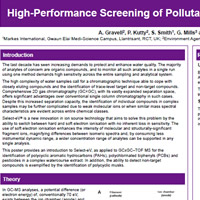
HIGH-PERFORMANCE SCREENING OF POLLUTANTS IN WATER USING GC×GC–TOF MS A. Gravell (2), P. Kutty (2), S. Smith (1), G. Mills (3) and Júlio César Cardoso da Silva (4) (1)Markes Int., Llantrisant, UK; (2)Environment Agency Wales, Llanelli, UK; (3)University of Ports Portsmouth, UK; (4) Nova Analítica, São Paulo, SP, BR |
Resumo do Pôster:The last decade has seen increasing demands to protect and enhance water quality. The majority of analytes of concern are organic compounds, and to monitor all such analytes in a single run using one method demands high sensitivity across the entire sampling and analytical system. The high complexity of water samples call for a chromatographic technique able to cope with closely eluting compounds and the identification of trace-level target and non-target compounds. Comprehensive 2D gas chromatography (GC×GC), with its vastly expanded separation space, offers significant advantages over conventional single column chromatography in such cases. Despite this increased separation capacity, the identification of individual compounds in complex samples may be further complicated due to weak molecular ions or when similar mass spectral characteristics are evident across entire chemical classes. Select-eV® is a new innovation in ion source technology that aims to solve this problem by the ability to switch between hard and soft electron ionisation with no inherent loss in sensitivity. The use of soft electron ionisation enhances the intensity of molecular and structurally-significant fragment ions, magnifying differences between isomeric spectra and, by consuming less instrumental dynamic range, a wider concentration range of analytes can be supported in any single analysis. This poster provides an introduction to Select-eV, as applied to GCxGC–TOF MS for the identification of polycyclic aromatic hydrocarbons (PAHs), polychlorinated biphenyls (PCBs) and pesticides in a complex watercourse extract. In addition, the ability to detect non-target compounds is exemplified by the identification of polycyclic musks. |
